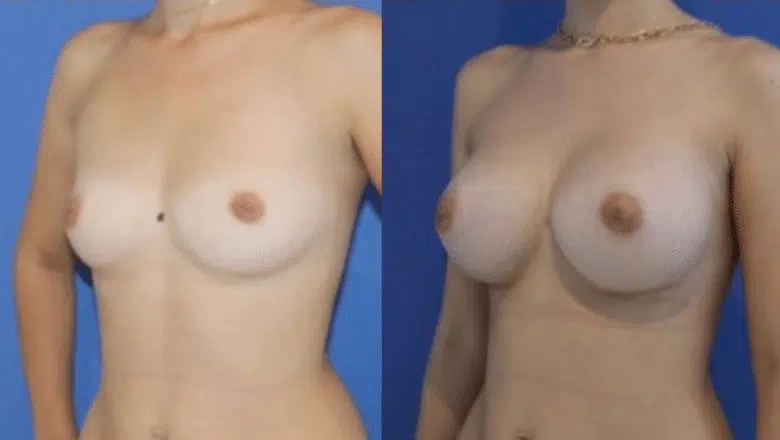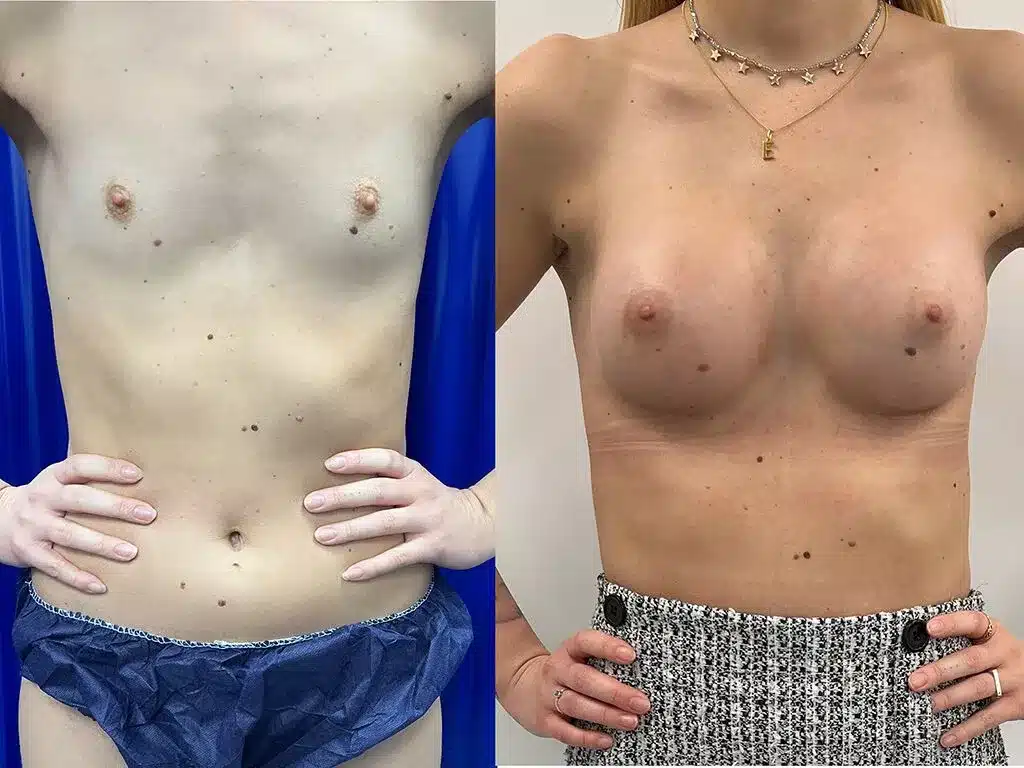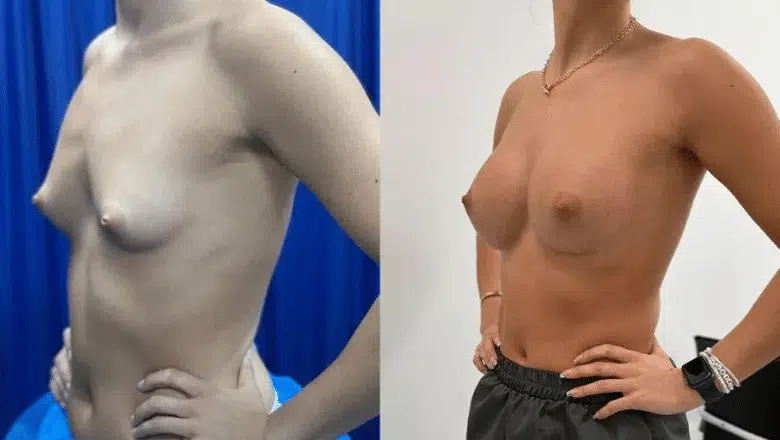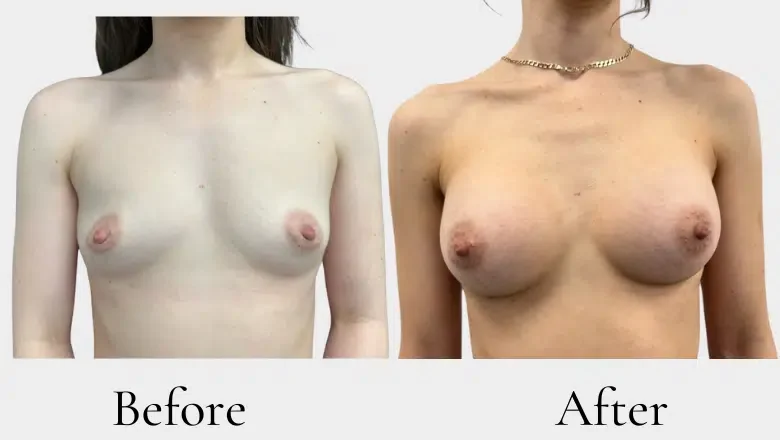Breast augmentation surgery is a procedure designed to alter the size and shape of the breasts. It is a significant decision that involves considering various factors. These include the type of implants, surgical techniques, and your desired outcome, which in this case may be achieving C cup breasts. At Centre for Surgery, our experienced surgeons will thoroughly discuss these options with you during your initial consultation. Rest assured that every detail will be taken into account to ensure beautiful and satisfying results.
It is important to note that the perception of a C-cup breast size can vary from person to person, as it will look different for each individual. It is crucial to consider different sizes and factors that contribute to your desired outcome. To assist in this process, your surgeon may employ 3D imaging during the consultation. This advanced technology allows you to visualise how different implant sizes, including a C cup breast implant, will appear on your specific body. By providing this visual representation, you can gain a better understanding of the potential outcome before committing to surgery.
What Are C Cup Breasts?
In the context of bra sizes, a ‘C’ cup denotes a specific volume and proportion in relation to the band size of the bra. This is a crucial element to understand as it relates to the overall fitting and comfort of the bra.
To exemplify this, let’s consider a bra labelled as a ’34C’. In this size designation, ’34’ indicates the band size, which is the circumference in inches around the body just under the bust. Thus, the ’34’ signifies that the band size is designed to snugly fit a torso that measures approximately 34 inches around.
The letter ‘C’ following the numerical figure represents the cup size. Herein lies the crucial aspect of understanding bra sizes. The ‘C’ doesn’t denote a fixed measurement but rather, it signifies a proportional relationship to the band size. Essentially, the ‘C’ means that the bra is designed to accommodate breasts that project around 3 inches further from the body than the under-bust measurement. This projection, often referred to as the ‘bust projection’, is calculated as the difference between the measurement around the fullest part of the bust and the band size.
Therefore, the cup size is not an absolute measurement, but rather a relative one, as it depends on the band size it’s associated with. For instance, the actual volume of a ‘C’ cup on a ’34’ band size bra might differ from the volume of a ‘C’ cup on a ’36’ band size bra. The principle here is that a larger band size requires a larger cup to maintain the same cup letter, even though the actual breast size is the same.
The term ‘C cup’ has become synonymous with a particular size in popular culture, but it’s important to understand that it actually describes a proportional measurement between the band size and the bust size. It’s the combination of these two measurements – the band size and the cup size – that create the final bra size and ultimately, determine the fit, support, and comfort that a bra provides.
Why Are C Cup Breasts Sometimes Considered the Perfect Breast Size?
C cup breasts are often hailed as the ideal breast size by many due to a combination of aesthetic appeal, functional benefits, and their suitability across a range of body types. This perception is rooted in several key factors that contribute to their popularity and the widespread notion of them being the ‘perfect’ size.
RELATED: What Do Perfect Breasts Look Like?
Proportional Aesthetics
One of the primary reasons C cup breasts are admired is their ability to appear symmetrical and well-proportioned on various body types. Unlike smaller sizes that may not achieve the desired prominence on certain frames, or larger sizes that may overwhelm a petite frame, C cups tend to offer a balanced look. This proportionality makes them a coveted size for those seeking harmony between their breasts and overall body silhouette.
Balanced Volume and Perkiness
C cups strike a coveted balance between volume and perkiness, a characteristic that is often sought after in breast aesthetics. They are full enough to provide a noticeable curve and shape, contributing to a classic feminine silhouette. However, they are not so large that they are prone to the effects of gravity as significantly as larger sizes, which can lead to sagging over time. This balance ensures that C cup breasts maintain a rounded and firm appearance longer.
Versatility in Fashion
The versatility C cup breasts offer in styling and fashion choices is another significant advantage. Individuals with this size can enjoy a broad range of clothing options without the limitations often experienced by those with very large breasts, such as difficulty finding well-fitting tops or the need for specialized support garments. C cups allow for the comfortable wear of figure-hugging outfits, plunging necklines, and strapless designs, providing both support and style flexibility.
Femininity and Body Definition
C cup breasts are often associated with a feminine and womanly look, adding definition and lift to the upper body without the need for undergarments that drastically alter one’s natural shape. This size enhances the body’s natural curves, offering a balanced and aesthetically pleasing figure that many find desirable.
Comfort and Reduced Physical Discomfort
From a practical standpoint, C cup breasts are less likely to cause the back, shoulder, and neck discomfort commonly reported by individuals with larger breasts. The relatively moderate weight of C cups means that they are unlikely to contribute to the physical strain and posture issues that can result from carrying heavier breasts. This aspect makes the C cup size appealing not only for its aesthetic and styling benefits but also for its contribution to overall comfort and well-being.
Factors Influencing the Determination of Breast Size
The size of a woman’s breasts is shaped by a host of interconnected factors. These include genetic predispositions, changes in body weight, fluctuations in hormones, the natural process of aging, and the physiological changes that occur during pregnancy and breastfeeding.
Genetics: Genetics plays a pivotal role in determining the size, contour, and fullness of breasts. It is the genes that decide the quantity of fatty tissue and glandular tissue present within the breasts, the mixture of which may result in a specific breast size such as the ‘C’ cup.
Age: With advancing age, women may observe changes in the appearance of their breasts. The skin may lose its elasticity, and the breast tissue may diminish, both of which could lead to a reduction in firmness and perceived size of the breasts.
Pregnancy and Breastfeeding: The hormonal changes and enhanced milk production that take place during pregnancy and breastfeeding often result in an increase in breast size.
Hormonal Changes: The size of the breasts is heavily influenced by hormonal fluctuations. The hormone known as estrogen is the primary agent responsible for the development of breasts. Levels of estrogen experience shifts during various stages in a woman’s life including puberty, menstrual cycles, pregnancy, and menopause, each of which can trigger alterations in breast size.
Body Weight: The correlation between body weight and breast size is noteworthy. Breasts consist predominantly of fatty tissues; therefore, an increase in total body fat could lead to a corresponding increase in breast size. Similarly, a decrease in body fat could lead to a reduction in breast size.
There are instances where women may wish to undergo breast augmentation surgery to attain a specific breast size, such as a ‘C’ cup or perhaps larger. The motivations for this decision can be manifold. Some women may feel that their breasts are too small in proportion to their body and desire an enhanced sense of balance, while others might be seeking to correct asymmetry or lack of perkiness in their breasts. There are also cases where women may opt for breast augmentation to recover the volume of their breasts that was lost due to pregnancy, substantial weight loss, or the effects of ageing.
However, it’s vital to stress that any decision regarding breast surgery should be made judiciously and ideally in consultation with a certified plastic surgeon. This way, one can be sure to get a comprehensive understanding of the procedure and its potential outcomes, making an informed decision. A consultation at Centre for Surgery in London offers the necessary expertise and guidance in making this personal decision.
Different Implant Choices for Achieving a C Cup Size – Saline, Silicone, and Gummy Bear Implants
For women seeking to achieve a C cup breast size through breast augmentation surgery, there are several types of implants available. The three most commonly used varieties are saline implants, silicone implants, and gummy bear implants. Each of these implant types has unique characteristics, and the choice between them generally depends on a woman’s personal preferences, her body type, and her surgeon’s recommendations.
- Saline Implants: These implants are filled with sterile saltwater, or saline solution. The saline is contained within a silicone shell, and these implants can be filled at the time of surgery to allow for minor modifications in size. In case of a rupture, the body naturally absorbs and expels the saline solution. However, saline implants might be more likely to show rippling and may not feel as natural as other implant types.
- Silicone Implants: Silicone implants are filled with silicone gel and are often favoured for their ability to mimic the feel of natural breast tissue. They come pre-filled in a range of sizes, and many women feel they offer a more natural look and feel than saline implants. If a silicone implant ruptures, the gel may remain within the shell, or it might escape into the breast implant pocket, but it’s not absorbed by the body. Regular check-ups with your surgeon are recommended to ensure the implant is functioning properly.
- Gummy Bear Implants: Also known as form-stable implants, gummy bear implants are a type of silicone implant that retains its shape even when the implant shell is broken. These implants are filled with a highly cohesive, form-stable gel that is thicker than traditional silicone gel. They are often teardrop-shaped, which can give a more natural look as they mimic the natural slope of the breast. However, if the implant rotates, it might lead to an unusual appearance of the breast.
RELATED: Silicone vs Saline Breast Implants
The choice between these types of implants is highly personal and depends on a variety of factors including the desired look and feel, body type, lifestyle, and the surgeon’s recommendations. The best decision can be made after a thorough discussion with a qualified plastic surgeon who can explain the advantages and disadvantages of each implant type. It’s also important to consider that all types of breast implants require regular monitoring and might need replacement over time.
RELATED: Mentor vs Motiva Breast Implants
Selecting the Appropriate Implant Size to get C Cup Boobs
Deciding on the most suitable breast implant size is an integral part of the overall surgical journey, a process that necessitates a cooperative relationship between the patient and the surgeon. There exist several strategies that surgeons employ to aid patients in deciding the optimal implant size. One of these tools, known as sizers, can offer patients a glimpse of what a C cup might look like on them.
RELATED: Ideal Breast Size Based on Height and Weight
Sizers: Sizers are essentially silicone inserts that can be placed within a bra, allowing patients to visualize their potential post-surgical appearance. They come in a range of sizes, enabling patients during their consultation to try out and see how different implant sizes might look on them. This also helps in identifying the size needed to achieve a C-cup breast size.
Determining the Size of C Cup Implants
When determining the size of the implants, it’s crucial to take into account your body type and personal aesthetic goals. The dimensions of your body will dictate which implant sizes will appear proportionate and harmonious with your figure. It’s essential to remember that a C cup size will look distinct on different body types.
Personal goals play a huge part in this process too, as every woman’s vision for her body differs. Some may desire a more modest enhancement in breast size, while others might be looking for a more noticeable transformation.
RELATED: How Breast Implant Sizes Relate to Bra Cup Sizes
For those contemplating C cup implants, it’s vital to note that choosing an implant size should be a carefully deliberated decision. At our Baker Street clinic, our surgeons carry out hundreds of breast surgeries each year, bringing a wealth of experience and expertise to the table. They are available to guide patients through this process, offering professional advice on selecting the appropriate implant size that aligns with the patient’s body type, personal goals, and preferences.
How Can I Measure My Cup Size?
The correct measurement of cup size is essential not only for understanding your current size but also for making informed decisions about potential implant sizes, for instance, if you’re considering achieving a C cup size. The cup size is derived from the difference between two specific measurements, with each size denoted by a letter that corresponds to a particular range of measurements. Below, we will guide you through the process of accurately measuring your cup size.
Measuring the Ribcage Begin by measuring the circumference of your ribcage, precisely below your breasts. This measurement represents the band size of your bra.
Measuring the Bust Following the ribcage measurement, the next step involves measuring the fullest part of your bust. Utilizing a flexible tape measure, take this measurement from both the front and back sides, ensuring to accurately capture the complete circumference of your bust. The difference in inches between the measurement of your band size and the bust size indicates your cup size. For instance, a C cup corresponds to a difference of approximately 3 inches.
Here is a general guideline for each cup size based on the difference in measurements:
- A Cup: If the difference between the bust measurement and the band size is approximately 1 inch, you fall into the ‘A’ cup category.
- B Cup: If the difference between the bust measurement and the band size is approximately 2 inches, you fall into the ‘B’ cup category.
- C Cup: If the difference between the bust measurement and the band size is approximately 3 inches, you fall into the ‘C’ cup category.
- D Cup: If the difference between the bust measurement and the band size is approximately 4 inches, you fall into the ‘D’ cup category.
By using this method, you can measure your cup size accurately and make educated decisions about your breast size.
C Cup Breast Augmentation Before and After Photos
RELATED: Breast Augmentation Before & After Photos
How Can I Get C Cup Breasts?
For many individuals, achieving a C cup breast size is a goal that can enhance confidence and satisfaction with their body image. There are several pathways to attain this desired breast size, each with its own set of procedures and outcomes. Understanding these options can help you make an informed decision that aligns with your aesthetic goals and health considerations.
Breast Augmentation with Implants
Breast augmentation using implants is a popular method for increasing breast size to a C cup. This procedure involves the insertion of silicone or saline prosthetics to add volume and fullness to the breasts. Implants are available in various shapes and sizes, allowing for customisation according to your aesthetic preferences, whether you’re seeking a subtle enhancement or a more noticeable enlargement. By choosing the appropriate size, implants can effectively increase breast size from an A or B cup to a C or even D cup, offering a tailored solution to meet individual needs.
The journey to recovery and the overall cost of breast augmentation can differ, depending on the type of implant chosen and other specific factors. Consulting with a professional surgeon can provide you with tailored advice and support tailored to your unique circumstances.
Fat Transfer to Breast
An alternative to implants, fat transfer to the breast offers a natural-looking augmentation by using the individual’s own fat cells. This procedure involves removing fat from other areas of the body, such as the thighs, via liposuction, and then injecting it into the breasts. Many prefer this method over traditional implants for its natural feel and appearance, and because it utilises the body’s own tissue.
Breast Lift Surgery
A breast lift, or mastopexy, is designed to rejuvenate deflated or sagging breasts by tightening the skin and internal tissues. This procedure can significantly enhance the shape and perkiness of the breasts, potentially increasing the breast size from an A or B cup to a C cup. A breast lift can restore a more youthful and lifted appearance, boosting confidence and satisfaction with one’s body.
Breast Reduction
For individuals experiencing discomfort or dissatisfaction due to excessively large breasts, a condition known as gigantomastia, breast reduction surgery provides a solution. This procedure aims to reduce breast size to a more manageable C cup by removing excess fat, tissue, and skin. In addition to reducing size, breast reduction can also lift and reshape the breasts, improving both comfort and appearance.
RELATED: How to Reduce Breast Size – Natural Remedies or Surgery?
Adhering to Pre- and Post-Operative Guidelines for Successful Achievement of C Cup Breasts
The importance of adhering to pre-operative and post-operative guidelines can’t be overstated when it comes to a successful breast augmentation surgery and an optimal recovery process. Patients are strongly urged to strictly follow these instructions to minimise potential complications and to attain the best possible surgical outcomes.
Preoperative Instructions
Before breast augmentation surgery, a surgeon will typically provide a series of instructions. This may involve avoiding certain medications or supplements known to increase bleeding risks, such as aspirin, ibuprofen, or vitamin E. Smoking cessation and limiting alcohol intake are also strongly recommended in the weeks preceding and following the surgery. These lifestyle modifications can contribute significantly to the healing process and overall surgical success.
Postoperative Instructions
Following the surgical procedure, patients will receive specific instructions about wound care, including maintaining cleanliness and dryness of the incision site, and adhering to a particular schedule for changing dressings. Medications are commonly prescribed post-surgery, typically including pain relievers and antibiotics to stave off potential infections. It’s of utmost importance to take these medications exactly as directed by the surgeon.
RELATED: Recovery After Breast Augmentation Surgery – Top Tips
Regular follow-up appointments are also a critical part of the post-operative care process. These visits allow the surgeon to monitor healing progress and address any concerns or queries that the patient may have. These appointments can also help catch any potential issues early, which can lead to quicker resolutions and better overall outcomes.
Exploring Natural Ways to Enhance Breast Size to a C Cup
Seeking methods to naturally increase breast size to a C cup without resorting to surgery is a common inquiry among many. While it’s important to acknowledge that significantly altering breast size naturally is challenging, there are several strategies that might offer subtle improvements in the appearance and shape of your breasts. Here’s an in-depth look at potential approaches:
Achieving a Balanced Body Weight
One of the most straightforward ways to influence your breast size is through weight management. Since breasts consist of fatty tissue, achieving or maintaining a healthy Body Mass Index (BMI) can sometimes lead to changes in breast volume. Gaining weight in a healthy manner might result in a slight increase in breast size, though it’s important to note that weight gain can affect individuals differently based on their body type and genetic predisposition.
Strengthening Chest Muscles through Exercise
Incorporating strength training exercises that focus on the chest, such as push-ups, chest presses, and other targeted workouts, can enhance the appearance of your breasts. These exercises won’t directly increase breast tissue but can strengthen the pectoral muscles beneath the breasts. A stronger chest can provide a subtle lift and make the breasts appear more pronounced.
Utilising Breast Enlargement Pumps
Breast enlargement pumps operate on the principle of suction to temporarily increase blood flow to the breast area. Some users report a minor, temporary enhancement in breast size and lift after consistent use. However, the effectiveness and longevity of the results vary significantly among individuals.
Optimising Bra Selection
The choice of bra can dramatically affect the appearance of your breasts. Opting for push-up, padded, or contour bras can create the illusion of a larger cup size by lifting the breasts and enhancing cleavage. This approach is about maximising what you have rather than physically increasing breast size but can be particularly effective for achieving a desired look under clothing.
Considering Supplements
There is a variety of natural supplements on the market claimed to support breast growth. Ingredients such as certain herbs and plant extracts are sometimes marketed as having the potential to mildly stimulate breast enlargement. However, scientific evidence backing the effectiveness of these supplements is limited, and they may not work for everyone. Additionally, it’s crucial to approach supplements with caution and consult with a healthcare provider before starting any new regimen, especially if you have underlying health conditions or are taking other medications.
Frequently Asked Questions About Achieving a C Cup Size
How big is C Cup?
A C cup size is a common measure used to denote a specific volume and dimension of the breast in relation to the ribcage. Essentially, it signifies that the circumference of the bust is approximately 3 inches (about 7.6 centimetres) more than that of the ribcage. However, it’s crucial to remember that the actual volume and appearance of a C cup can differ significantly from person to person. This variation is because the cup size is influenced by the band size; for instance, a 32C has a smaller overall volume than a 36C. Despite these differences, a C cup is generally regarded as a moderate size, offering a balanced and natural look that many find desirable.
Is There a Difference in Breast Size Across Different Ethnicities?
It is indeed observed that breast size can vary across different ethnic groups, largely due to genetic and physiological factors. Research and anecdotal evidence suggest that certain ethnicities may, on average, have larger breast sizes than others. This phenomenon is influenced by a combination of genetics, body composition, and other health-related factors. For example, populations with higher rates of obesity might also exhibit larger average breast sizes, as increased body fat can contribute to larger breasts.
Can breast augmentation affect breastfeeding?
Yes, breastfeeding with implants is possible, but the implants can impact breastfeeding under certain circumstances. The size and placement of the implants generally do not affect most women’s milk production. However, in some instances, some women might experience a reduction in milk production. As per the available literature, about 75% of women with breast implants have been successful in breastfeeding. It’s important to discuss these considerations with your surgeon when planning for breast augmentation.
RELATED: Can Pregnancy Ruin My Breast Implants?
What is involved with the recovery process after a breast augmentation procedure?
Recovery following breast augmentation is a vital aspect that should be considered for making a well-informed decision about the surgery. Generally, full recovery takes about six weeks, with a recommended 1-2 weeks off work and regular daily activities.
What varieties of implants are available?
There are different shapes of implants to consider, namely round and teardrop. Round implants offer a fuller projection, while teardrop implants provide a more naturally shaped and projected look.
RELATED: Round vs Teardrop Implants – Choosing The Best Breast Implant Shape
Moreover, it’s important to consider the profile of the breast implants. A low-profile implant offers the least projection and is most commonly used when a subtle increase in breast size is desired.
A moderate profile implant offers a moderate level of projection and is often chosen for achieving a natural appearance with a bit of cleavage. High-profile implants offer the greatest level of projection and are commonly chosen when a more pronounced look and a dramatic increase in size are desired.
Choosing Centre for Surgery for C Cup Breast Augmentation
Centre for Surgery is a top choice for patients seeking to achieve a C cup size through breast augmentation, and here’s why:
- Specialised Surgeons: Our team is composed of highly trained and experienced surgeons, each having undertaken a significant number of successful breast augmentation procedures. Their wealth of knowledge allows them to deliver the best possible results tailored to your unique body type and personal aesthetic goals.
- Customised Care: We understand that each patient is unique, both in their physique and in what they wish to achieve through surgery. That’s why we pride ourselves on offering a bespoke approach to every procedure, ensuring that your individual needs and aspirations are at the forefront of your surgical journey.
- State-of-the-art Techniques and Technology: At Centre for Surgery, we continuously stay abreast of the latest advancements in the field of cosmetic surgery. By adopting cutting-edge technologies and surgical techniques, we ensure our patients receive the most effective, minimally invasive, and safe procedures possible.
- Unwavering Commitment to Patient Safety: Your safety is our utmost priority. We uphold stringent standards of clinical excellence and perform all procedures in a secure, controlled environment to ensure maximum patient safety.
- Comprehensive Aftercare: Our commitment to your well-being doesn’t end when the surgery does. We provide robust post-operative care, with our dedicated team readily available to address any questions or concerns you might have during your recovery period. We also conduct regular follow-up consultations to monitor your progress and ensure optimal healing and outcomes.
- Transparent Pricing: At Centre for Surgery, we believe in clear and upfront communication about costs. We provide transparent pricing without any hidden charges, ensuring you know exactly what to expect.
Choosing Centre for Surgery for your transition to a C cup means choosing unparalleled expertise, personalised care, and unwavering support throughout your surgical journey. We are here to help you achieve your aesthetic goals and enhance your self-confidence.





























































